Plastic slats are becoming more popular among sheep farmers to ease the workload involved in winter housing. Plastic slats are versatile and can be used in different situations where existing housing is already in place. Many farmers are switching from straw-bedded sheds to plastic slatted areas because the workload involved in strawbedding regularly is taken out.
Farmers feel there are also extra bonuses with plastic slats in that there are less lameness issues in flocks housed on slats and the incidence of scour in lambs can be reduced with the improved hygiene.
Here, we feature a Cavan farmer who has installed slats in an existing dry floor hay shed. It looks an impressive job and highlights what can be done to utilise existing sheds on the farm efficiently. He used to keep his 100 in-lamb ewes outdoors until lambing time, but decided it would be better to house ewes earlier in order to have fresh grass for ewes after lambing.
According to the farmer, the plastic slats were ideal for his situation because he didn’t want the continued cost of bedding sheep every year and the labour that goes with it.
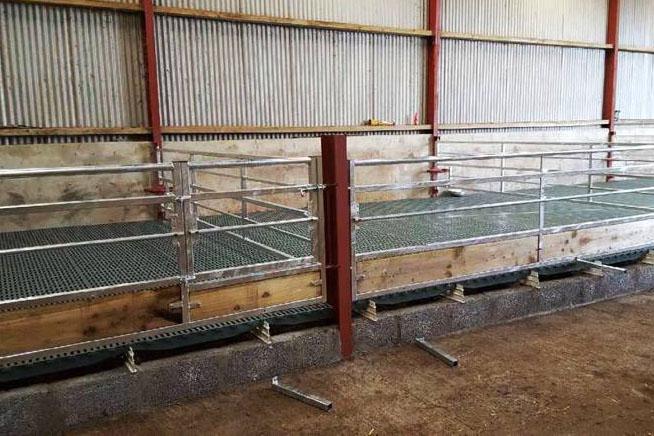
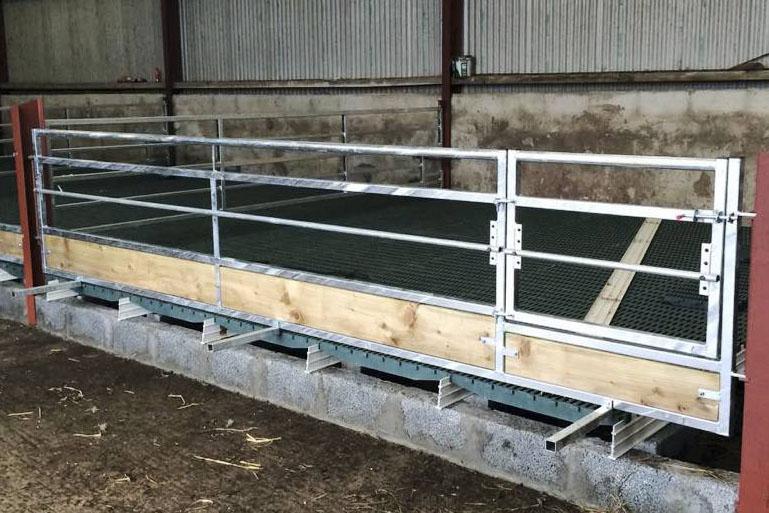
Pictures one and two
The farmer bought the Premium T14 slats from Jetwash Ltd in Carrigallen, Co Leitrim. In total, four bays of the dry bed shed were used, taking up a total of 90m2 of floor space. Nine-inch concrete blocks were laid on their edge on the perimeter of where the pens were planned. They were also laid to support the fibreglass runners along the back wall and through the middle.
There is a space of just 3ft between each row of fibreglass runners. The slats came in 1m2 pieces. The farmer said it was very easy to fit the slats on the runners and compared it with a simple jigsaw. The slats are 15in above the original concrete floor, which should provide ample space for the manure to build up during the housing period. The farmer said that if he finds there isn’t enough manure storage space in the void, he could raise the floor higher by putting in another row of blocks.
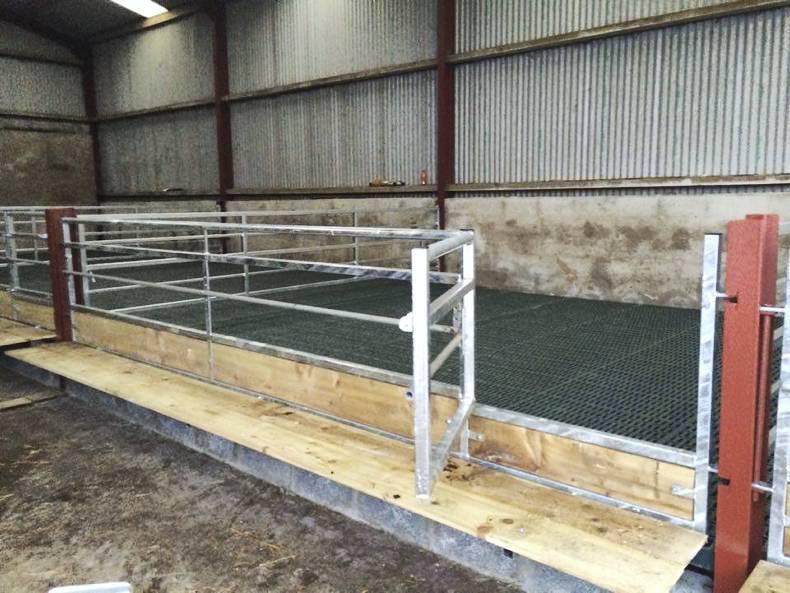
Picture three
Because the slats are at a height, the farmer plans to build a small ramp to enable access for the ewes at housing time. For feeding ewes, timbers were erected approximately 2ft from the barrier, which are supported by steel bars that are bolted to the base of the barrier.
Each pen is 15ft wide (at the feed barrier) by 16ft deep and can hold 25 in-lamb ewes. There are no walk-through feeders in the shed but the farmer plans to use small hook-on meal feeders, which will be hooked to the dividing gates in the pens.
At meal feeding time, these feeders will accommodate the ewes that don’t fit at the front barrier. Baled silage will be placed on the wooden boards and kept topped up in front of ewes all the time. After a ewe lambs, the small gate can be opened for an easy exit of the ewe and freshly born lamb. The farmer says that a ewe will have no problem stepping down from the slatted area when taken out of the pen.
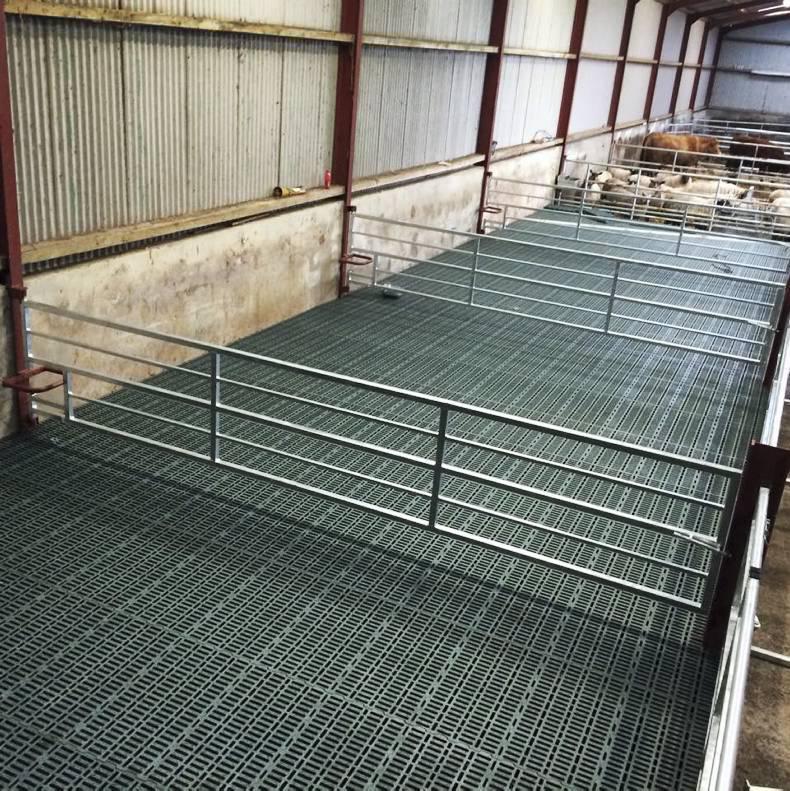
Picture four
The centre gates cannot be taken down easily because they are fixed permanently to the stanchions of the shed. However, they are hinged and can be opened back against the wall if the shed is being cleaned or used to store straw. The rest of the penning is all removable and can be lifted away, including the stanchion holding the feeding barriers, which are just bolted to the floor.
Water troughs will be put in at the back of the shed shortly. The slats and the fibreglass supports cost €4,850, including VAT, and penning cost €2,500, including VAT. In total, it cost €7,350, including VAT, to erect the slats and penning for the 100 ewes.
The farmer didn’t apply for a grant to subsidise this work, which would have brought down the cost significantly. He says he is delighted with the way it came out and hopes it will make lambing time far easier. He plans to finish store lambs on the slats at different times of the year.
Pictures five, six and seven
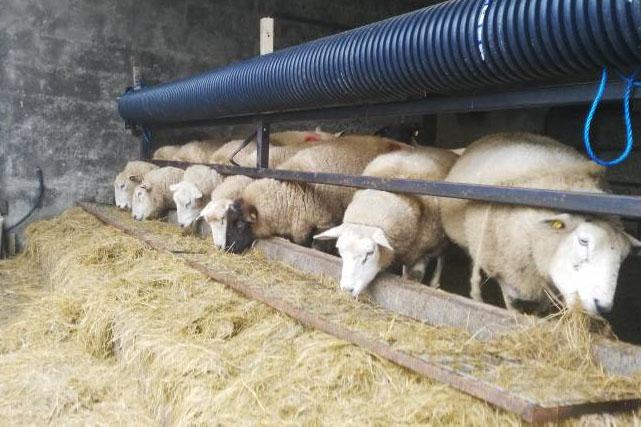
The Irish Farmers Journal visited another sheep farm in the west with slatted sheep housing. The farmer had implemented an innovative idea to prevent sheep from pulling silage and hay into the slatted area. A steel mesh with three-inch square holes was welded to a frame.
The frame is on a runner connected to the pillars of the shed and can go up and down. When the mesh frame is left on top of the silage, the sheep can pick it through the holes but can’t pull big quantities of silage out (picture five above).
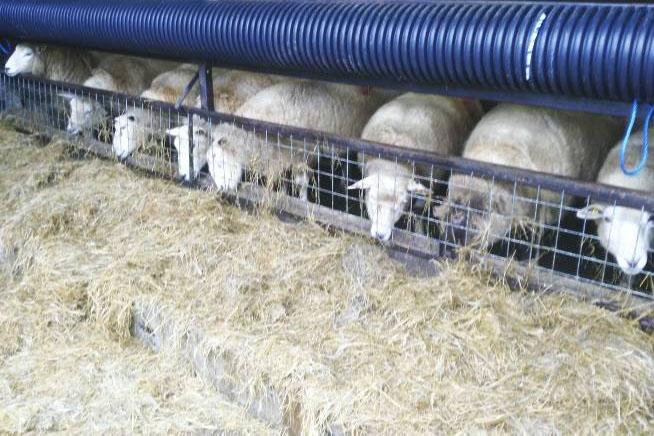
The farmer says that ewes have no problem eating silage down to the ground with this device.
When the silage is all gone, the mesh is folded back against the barrier and a hook keeps it in place (picture six above). Waste silage can easily be cleaned away and new silage can be fed out when the mesh is up. Once a new bale is forked in, the mesh can be let down on top of the silage again and sheep can pick at the silage as before.
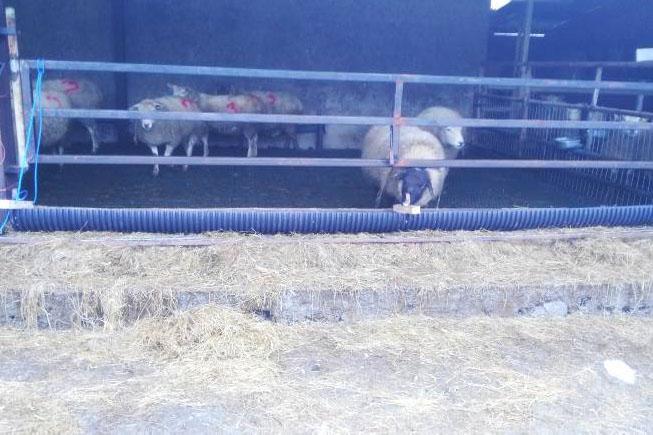
To feed meal, the farmer cut a nine-inch corrugated pipe in half and attached it to the feed barrier.
The pipe is left on the silage area when concentrates are being fed to the ewes and, once they are finished, timber hooks fixed to the pipe allow it to be secured to the barrier above out of the way (picture seven above).
The farmer has ropes tied to the pipe so that the sheep can’t push it away. This is a relatively cheap way of preventing slats from getting clogged up with silage.
The farmer says he has no problem with silage on the slats now, but finds that there is wool starting to clog it up. He is considering winter shearing to avoid this problem next year.
It is now possible to apply for grant aid for sheep slats via the Targeted Agricultural Modernisation Scheme (TAMS II).
Farmers who make a successful application and purchase the correct spec slats are entitled to at least 40% of a grant towards the cost of purchasing the plastic slats. In Table 1, companies producing plastic sheep slats that are eligible for use in grant-aided sheep housing are listed.
According to the Department, plastic sheep slats supplied by manufacturers not on this list cannot be grant-aided.
The list is updated regularly and the most up-to-date list will be available on the table. This should help to give readers an idea of the cost involved in investing in sheep slats on their farms.
All of the suppliers said that prices vary depending on the size of the job undertaken, the type of supports used and the thickness of supports.
Read more
Full coverage: TAMS II
Plastic slats are becoming more popular among sheep farmers to ease the workload involved in winter housing. Plastic slats are versatile and can be used in different situations where existing housing is already in place. Many farmers are switching from straw-bedded sheds to plastic slatted areas because the workload involved in strawbedding regularly is taken out.
Farmers feel there are also extra bonuses with plastic slats in that there are less lameness issues in flocks housed on slats and the incidence of scour in lambs can be reduced with the improved hygiene.
Here, we feature a Cavan farmer who has installed slats in an existing dry floor hay shed. It looks an impressive job and highlights what can be done to utilise existing sheds on the farm efficiently. He used to keep his 100 in-lamb ewes outdoors until lambing time, but decided it would be better to house ewes earlier in order to have fresh grass for ewes after lambing.
According to the farmer, the plastic slats were ideal for his situation because he didn’t want the continued cost of bedding sheep every year and the labour that goes with it.


Pictures one and two
The farmer bought the Premium T14 slats from Jetwash Ltd in Carrigallen, Co Leitrim. In total, four bays of the dry bed shed were used, taking up a total of 90m2 of floor space. Nine-inch concrete blocks were laid on their edge on the perimeter of where the pens were planned. They were also laid to support the fibreglass runners along the back wall and through the middle.
There is a space of just 3ft between each row of fibreglass runners. The slats came in 1m2 pieces. The farmer said it was very easy to fit the slats on the runners and compared it with a simple jigsaw. The slats are 15in above the original concrete floor, which should provide ample space for the manure to build up during the housing period. The farmer said that if he finds there isn’t enough manure storage space in the void, he could raise the floor higher by putting in another row of blocks.

Picture three
Because the slats are at a height, the farmer plans to build a small ramp to enable access for the ewes at housing time. For feeding ewes, timbers were erected approximately 2ft from the barrier, which are supported by steel bars that are bolted to the base of the barrier.
Each pen is 15ft wide (at the feed barrier) by 16ft deep and can hold 25 in-lamb ewes. There are no walk-through feeders in the shed but the farmer plans to use small hook-on meal feeders, which will be hooked to the dividing gates in the pens.
At meal feeding time, these feeders will accommodate the ewes that don’t fit at the front barrier. Baled silage will be placed on the wooden boards and kept topped up in front of ewes all the time. After a ewe lambs, the small gate can be opened for an easy exit of the ewe and freshly born lamb. The farmer says that a ewe will have no problem stepping down from the slatted area when taken out of the pen.

Picture four
The centre gates cannot be taken down easily because they are fixed permanently to the stanchions of the shed. However, they are hinged and can be opened back against the wall if the shed is being cleaned or used to store straw. The rest of the penning is all removable and can be lifted away, including the stanchion holding the feeding barriers, which are just bolted to the floor.
Water troughs will be put in at the back of the shed shortly. The slats and the fibreglass supports cost €4,850, including VAT, and penning cost €2,500, including VAT. In total, it cost €7,350, including VAT, to erect the slats and penning for the 100 ewes.
The farmer didn’t apply for a grant to subsidise this work, which would have brought down the cost significantly. He says he is delighted with the way it came out and hopes it will make lambing time far easier. He plans to finish store lambs on the slats at different times of the year.
Pictures five, six and seven

The Irish Farmers Journal visited another sheep farm in the west with slatted sheep housing. The farmer had implemented an innovative idea to prevent sheep from pulling silage and hay into the slatted area. A steel mesh with three-inch square holes was welded to a frame.
The frame is on a runner connected to the pillars of the shed and can go up and down. When the mesh frame is left on top of the silage, the sheep can pick it through the holes but can’t pull big quantities of silage out (picture five above).

The farmer says that ewes have no problem eating silage down to the ground with this device.
When the silage is all gone, the mesh is folded back against the barrier and a hook keeps it in place (picture six above). Waste silage can easily be cleaned away and new silage can be fed out when the mesh is up. Once a new bale is forked in, the mesh can be let down on top of the silage again and sheep can pick at the silage as before.

To feed meal, the farmer cut a nine-inch corrugated pipe in half and attached it to the feed barrier.
The pipe is left on the silage area when concentrates are being fed to the ewes and, once they are finished, timber hooks fixed to the pipe allow it to be secured to the barrier above out of the way (picture seven above).
The farmer has ropes tied to the pipe so that the sheep can’t push it away. This is a relatively cheap way of preventing slats from getting clogged up with silage.
The farmer says he has no problem with silage on the slats now, but finds that there is wool starting to clog it up. He is considering winter shearing to avoid this problem next year.
It is now possible to apply for grant aid for sheep slats via the Targeted Agricultural Modernisation Scheme (TAMS II).
Farmers who make a successful application and purchase the correct spec slats are entitled to at least 40% of a grant towards the cost of purchasing the plastic slats. In Table 1, companies producing plastic sheep slats that are eligible for use in grant-aided sheep housing are listed.
According to the Department, plastic sheep slats supplied by manufacturers not on this list cannot be grant-aided.
The list is updated regularly and the most up-to-date list will be available on the table. This should help to give readers an idea of the cost involved in investing in sheep slats on their farms.
All of the suppliers said that prices vary depending on the size of the job undertaken, the type of supports used and the thickness of supports.
Read more
Full coverage: TAMS II








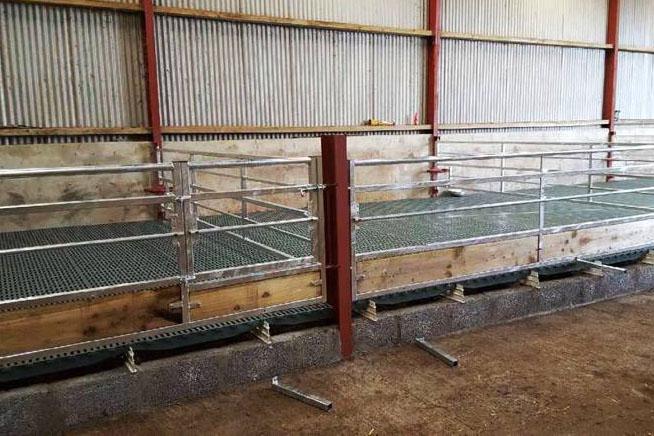




 This is a subscriber-only article
This is a subscriber-only article











SHARING OPTIONS: